Avatar: the Way of Water (2022 | USA | 192 minutes | James Cameron)
More than a decade in the making, James Cameron has at long last returned to Pandora, the lush reource-rich moon inhabited by tall blue cat people with swimmers builds that put Michael Phelps to shame, whose bioluminescent nature consciousness was the setting for his own massively-successful and boundary-pushing success Avatar. It’s a three hour long trip to the cutting edge of filmmaking technologies, a three-dimensional marvel of variable frame rates, and a story of a family on the run that demands to be seen in a cinema, nausea be damned.
Morgen and I got a chance to see a sneak peek before it takes over multiplexes everywhere (I got a more sedate press-only preview, she braved a packed house promotional screening, both in the Pacific Science Center’s massive screen immersive IMAX theater. After returning to earth, we chatted about the experience.
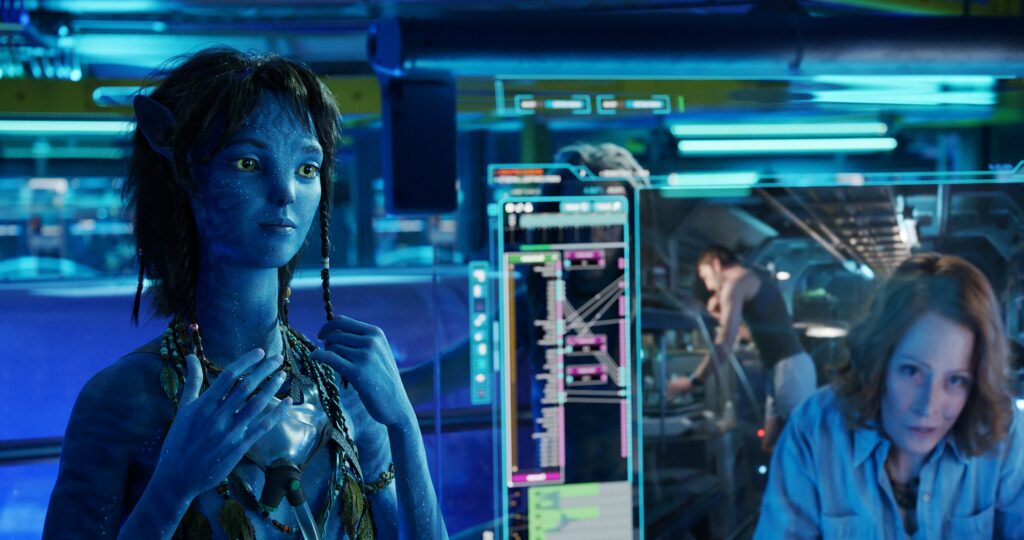
Josh: OK, before we dive into the rippling cerulean waters and verdant forests of Pandora, I’ll take a stab at a plot synopsis.
Those who re-watched Avatar or a crash-course explainer will vaguely recall that in the first film, Earthlings had developed a technology to grow Na’vi hybrids in goop tanks and let humans “drive” them through long-distance Matrix-like WiFi so that they could frolic and interact with Pandora natives on their own ten-foot-tall blue-bodied terms and not immediately die from all the carbon dioxide in the atmosphere. The action of the first film involves a Big Evil Corporation making a play for a precious metal (Unobtanium) that just happens to be buried below a Na’vi sacred site: a huge glowing tree that’s allows the Na’vi to hardwire their glowing braids into the planetary consciousness. The Good Humans – led by Sam Worthington’s deep cover soldier operative (Jake) who’s fallen in love with a Na’vi princess (Zoe Saldana’s Neytiri) – collaborate with the indigenous forest dwellers to kick the Earthlings off the planet. Oh, and Big Glowing Tree Magic allows Jake to transcend his dying parapalegic body such that his consciousness can dwell in his lithe new Na’vi body full time. Whew.
As the sequel opens, it’s been about ten years since the rapacious Sky People of Earth have been kicked off of Pandora. In the intervening years, explained in subtitled Na’vi voiceover, Jake and Nyteri have settled down and grown their family: two sons (Jamie Flatters as Neteyam, the older dutiful one who’s the perfect soldier and Britain Dalton as Lo’ak, the younger one who says “bro” a lot and can’t live up to expectations) and a cute little blue baby tiger girl. They’ve also adopted Kiri, the mysterious miracle baby that spontaneously grew in the womb of the Avatar once inhabited by Sigourney Weaver’s scientist Dr. Grace Augustine (tree magic couldn’t give her a postmortem consciousness transfer, but the small devoted remaining science team kept the Avatar in the lab as a souvenir). The teen is also played by Weaver and it’s among the more convincing motion-capture / deaging performances I’ve ever seen. Finally, “because babies can’t go in cryo-storage to return to Earth” there’s a human kid played by Jack Champion kid born soon after named Spider has grown up on the planet, galavanting through the forest with the assistance of an oxygen mask, painting his body with tiger stripes to better fit in with his much stronger and taller compatriots and their perfect stretchy swimmer’s builds.
After this idyllic lull of galavanting among wondrous flora and fauna, an ominous bright new star in the sky alerts the Na’vi that the Earthlings are back (with a vengeance). Soon they fire up the insurrection on goose-faced dragonback to chase the invasive copters from the floating sky mountains. After a couple years of this, Earth gets fed up and sends in a Marine strike force (hoo rah!) comprised of soldiers whose consciousnesses were copied to USB sticks before they died and later permanently imprinted in recombinant Na’vi bodies. This narrative loophole allows the first movie’s chief antagonist (Stephen Lang’s Colonel Quaritch) to return from the dead, albeit bigger and bluer, but still full of blinkered righteous conquest energy and motivated by pure vengeance. They’re tasked with taking down the insurgency led by Jake and the Forest People who’ve been thwarting whatever plundering the earthlings have planned for the planet.
Eventually, Jake recognizes that he’s made his whole tribe a target, packs up the family, and goes into hiding. This opens up the world of Pandora dramatically and gives Cameron a vast new three dimensional canvas to expand his world, introducing the Metkayina, a whole new, slightly greener race of Pandorans, and their way of life among the scattered reef islands of the planet’s oceans. It’s here that we meet Kate Winslet as Ronal and Cliff Curtis as Tonowari as the village’s deep-diving leaders (some borrowed Maori imagery) as well as their daughter Tsireya (a dreamy love interest portrayed by Bailey Bass) and brash son Aonung (a modest antagonist for the Sully teens played by Filip Geljo). It’s also where Cameron’s interest in creature design and world building shines the brightest, using inventive filmmaking techniques, woozy high frame rates, and sophisticated motion capture to create a world that you’re easily invested in preserving. Because, lest we forget, there’s a power-hungry occupying presence with guns, technology, and profiteering greed just over the horizon and they’re waiting to pounce.
The final act unfolds into a breathtaking finale that’s both familiar yet like nothing I’ve ever seen or felt on screen. Cameron serves up eye-popping spectacle after spectacle as the confrontation comes to a head (on several escalating fronts and on macro- and personal-level scales). These bombastic sea battles of technology versus nature are heightened by the hours spent getting to know the families enmeshed in the conflict and imperiled by the invasion, and allow Cameron to replay some of his greatest hits (sinking ships, a favorite) on the grandest possible scale and with dizzying resolution. Plan your hydration and bathroom breaks accordingly because you’re bound to be glued to your seats during the relentless hourlong climax.
For me at least, it gets a positive review and an easy recommendation.
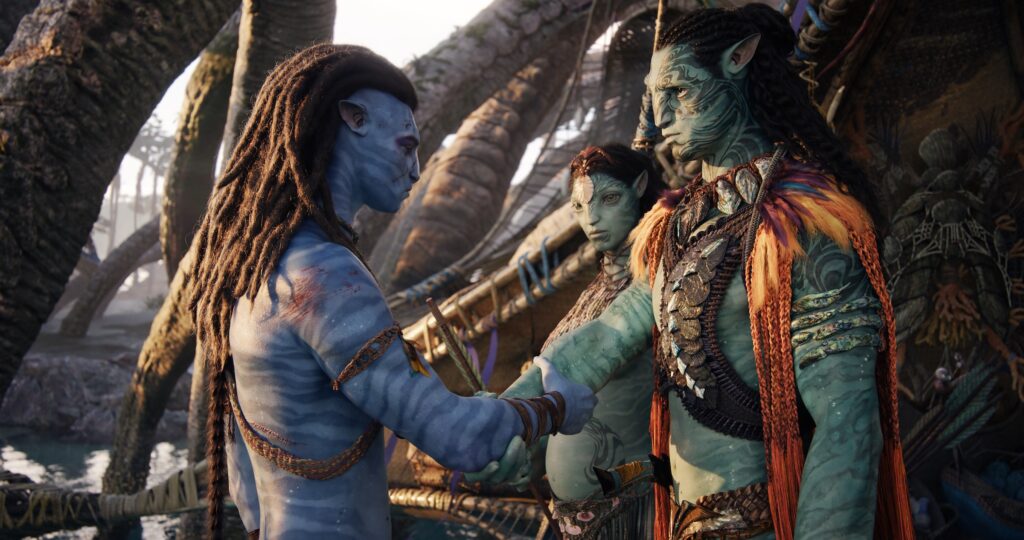
Before seeing it, how excited were you about returning to Pandora? How much of the original story did you remember?
Josh: Every time I’d see another news item about how the Avatar sequels had been delayed another year, I’d chuckle to myself and wonder if they were real, and if so, why any effort was going into making more of these. I remember thinking that the original was beautiful to look at in the theater, but basically hadn’t thought about it for more than a few hours after leaving that screening more than a decade ago. I definitely didn’t remember anything about the plot beyond “earthlings in big blue bodies … unubtanium (lol) … people bad, nature good … something about trippy tree planetary internet”. That was enough to get me through the new one, but I probably should’ve watched a ten minute refresher before settling down for the three hour return tour.
Morgen: I knew the film was coming… like actually coming up, no empty promises; so about six months ago I watched it again in the comfort of my home to prepare. The hype had me excited for the next chapter, even though it promised a bladder-buster 3+ hours of film. I remember how unique and beautiful the first one seemed and while other environmental movies had attempted the same storyline, this one actually accomplished what it was going after despite the chuckles and mockery about the Na’vi.
Josh: Skepticism aside, rapturous reactions from early screenings had me scrambling to accept a preview screening and all the hype was correct, this sequel is a hell of a moviegoing experience! As they say on the hype boards, never bet against Big Jim.
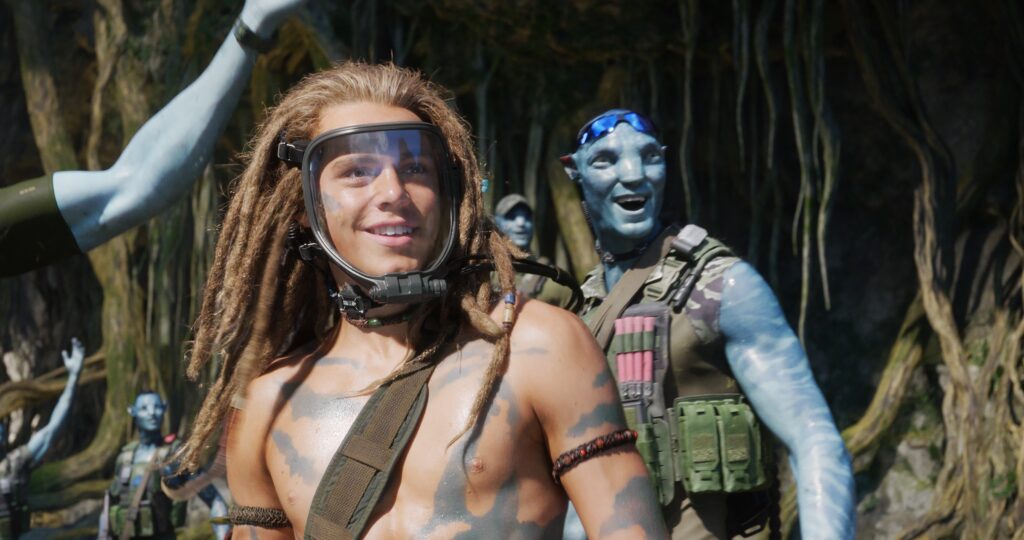
OK, let’s get into some reactions. How many times did you repurpose your popcorn tub as an airsick bag while watching the Way of Water?
Morgen: I was wondering if this would come up in our discussion. My viewing was jam packed and moving around after it started wasn’t exactly an option. To add insult to injury, the last few years I’ve noticed a severe uptick in vertigo during certain films where I either have to close my eyes and just listen or actually leave (the first-person shaky camerawork of What We Do In The Shadows is a good example). With leaving not in the cards, I found myself removing my 3D glasses at least half-dozen times. Honestly though, it wasn’t all that bad to watch without them, just a little blurry, and the visuals were almost as good in “2” dimensions as they were in “3”.
Josh: I was very close to losing it at least three times. To the chagrin of my fellow critics, I grabbed my usual preferred center-center seat at PacSci’s true IMAX at the beginning of the film, but ran for a seat a dozen rows further back after a few minutes of Papyrus Toruk subtitles were smashed into my face. I can’t say that I ever got totally over the reflected glare on the inside of my glasses – the bright screen bouncing back PacSci’s bright red stadium seats might be the culprit – or fully accustomed to the intermittent high frame rate and immersive 3D. I left feeling overwhelmed and woozy, but the novelty of the spectacle and the otherworldly quality of the effects won me over enough to recommend the ride in the best possible theater you can find.
Morgen: If I’d had my druthers, I probably wouldn’t have chosen the 3D, the way it’s been used in the past has always seemed too gimmicky. However, when I was able to keep the glasses on and really take in the experience, it was quite incredible. Cameron wants us to feel like we’re there; not just watching but interacting, and he did a hell of a job.
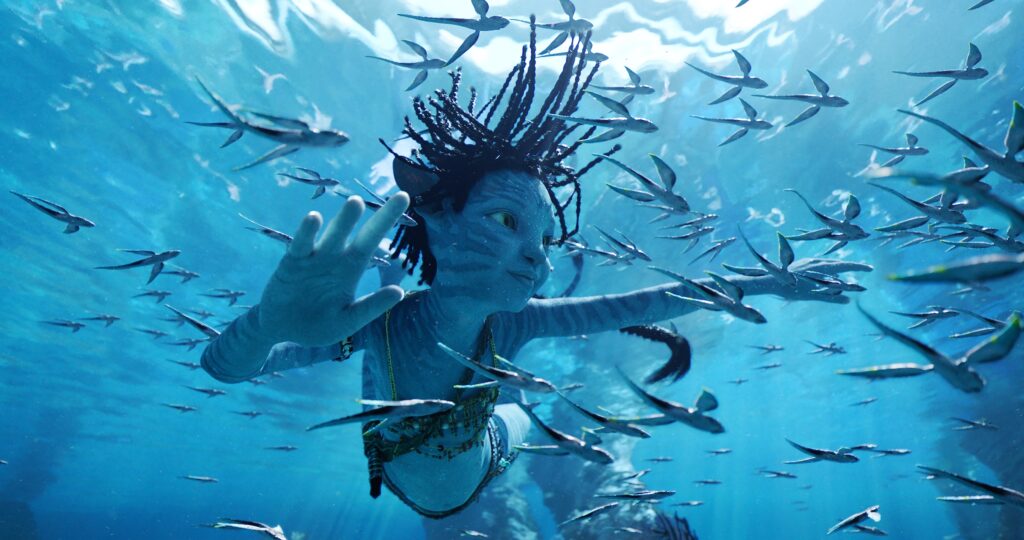
Big Picture: better/worse than the original?
Morgen: I’m torn. I enjoyed the first film as something new, even if it was playing off stories that had been done to death. It felt interesting, fresh and intriguing. The second felt like a remake of the first but the characters had aged a bit.
Josh: Oh wow, for me it was so much better. The plot isn’t deep deep but it’s far more character driven and the addition of a family element and a bunch of tweenage catlike aliens takes the weight off the military/science/regimented clear bright lines of the original. The downside of this is that the plot mechanics are overly reliant on the tried-and-true trope of kids not listening to their parents, getting into perilous situations, and posing existential threats to entire societies of nature-loving aliens.
Morgen: Agreed, the kids added a new facet to the plot and with them came the discussion of identity, racism and ableism. But, I counted three different times the parents admonished their kids for not doing what they said and the same arc happened three times when they ignored their warnings. I actually rolled my eyes the third time, there was definitely space for him to come up with a different arc, but he just didn’t bother? Maybe I’m being too hard on them but there was potential for something really interesting and Cameron just didn’t go that extra mile. If you’re going to keep me in my seat for over three hours make it worth my while.
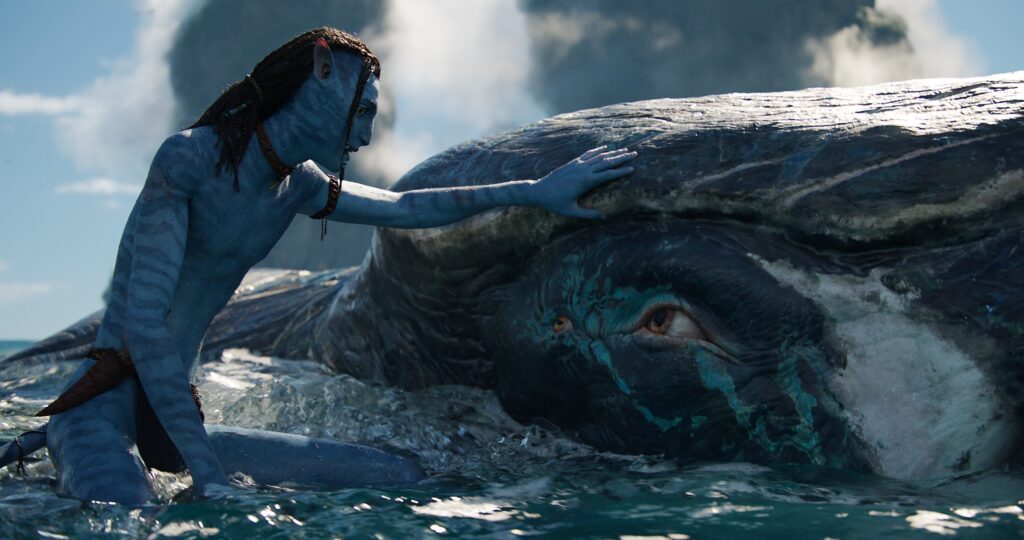
High points of the three hour tour?
Josh: There’s a middle section where not much happens beyond the Forest Na’vi learning not to be utterly useless as Reef Na’vi that’s utterly magical. The underwater motion capture and survey of Pandora’s sea creatures is utterly intoxicating. It’s the highest quality nature film you can possibly imagine and the perfect speed for me and 3D. I wanted to live in that part of the film forever. Our heroes learn to ride winged ocean dolphin dragons and bond with super-intelligent roving whale-like creatures who speak in . They have little crushes and bliss out observing anemone. The boys try to make friends with new rivals and get in over their heads. It’s a complete dream, I could’ve stayed there forever. From a storytelling point of view, I can see how some might complain about this lull, but this investment in time and of the bioluminescent blue world has the effect of bonding the audience to this planet and allying you in righteous anger against the “alien” humans who seek to destroy the world and its inhabitants for their own benefit.
Morgen: I’m 100% on board with Josh, the sea Na’vi were my favorite part with their adapted bodies. What I really loved was they hadn’t grown gills, but learned to breathe deeply and long like The Bajau of Southeast Asia. That plot point gave the forest Na’vi the ability to learn rather than be hampered by their differently evolved bodies. In the grand scheme that’s a small thing, but to me it’s incredibly thoughtful and a good example of how decisions they made in the making of the film, both small and large, made a huge difference in the end.
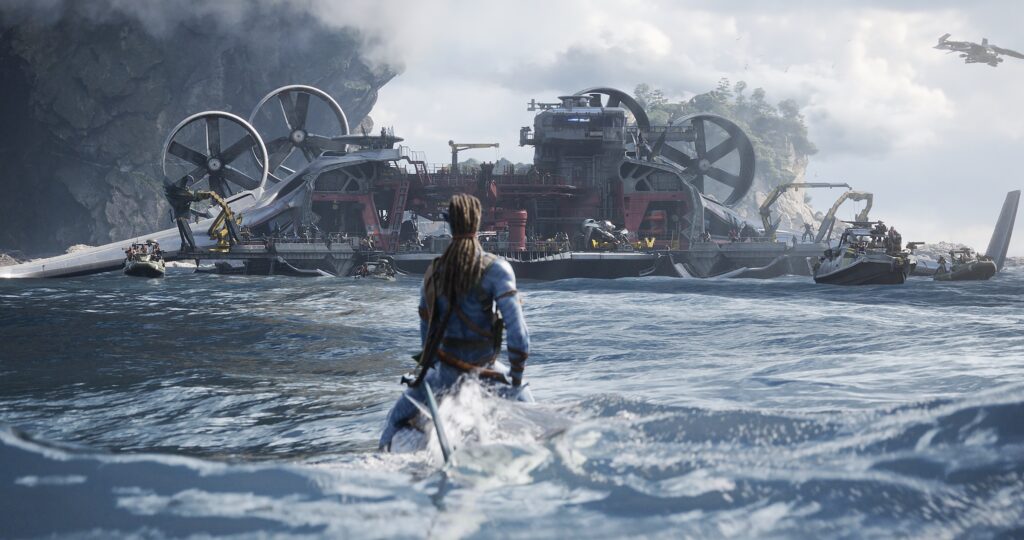
The highs are high, what about the lows?
Josh: Not exactly a low point … but the plot is basically Moby Dick, which is a fine source of inspiration. But it repeats itself several times over, bigger, louder, and not especially nuanced. We have a maniacal revenge plot to settle an old score … except here the deranged captain is also avenging his own murder (brain transfer is complicated, but it allows a clever Poor Yorick moment) while taking down a pesky insurgent whose wife offed him. Plus there’s also literal whaling (or, rather the harvest of sentient Tukun) layered on top of it as an example of immense cruelty.
Morgen: Yes, all of this. There wasn’t any feeling of newness or originality separating it from the first film. As the credits rolled, I found myself asking why they even left their forest brethren if they ended up staying to fight with their new sea-faring family? They were more adept at fighting in the forest, so why? Because it would have been over in 45 minutes if they’d stayed. So, there it is, the movie felt sort of pointless at the end because they put all their new friends in danger like they had tried to avoid with their old friends. Runner up for low point, Jemaine Clement with a boring American accent.
Josh: If something’s immersive enough and the vibe is right I don’t care about plot, or at least lengthy explanations to explain every corner of the world, so the vagaries of galactic corporate intrigue, the hand-waving around Pandora’s consciousness, and the murky geopolitics of the various Na’vi are well suited to my level of nerdery. But as previously discussed, I did get annoyed by how much of the conflict relies on kids being dumb, which is both universal and less credible when it happens the third or fourth time in exactly the same way. It further relies on the salty old general to be so hellbent on revenge that he repeats his mistakes over and over again and never learns anything. I began to wish for any other plot mechanism other than repetitive hostage-taking. Not that I wanted any of those adorable blue kiddos to get axed but feel like the script supervisor who didn’t push for anything more creative deserves a “c’mon man …”
Is this the future of movies?
Morgen: I hope not. Is that mean? I’ll expand, I hope that there are better plots and thought arcs for three-hour movies in the future. The 3D filming was gorgeous, but only during certain parts, otherwise you better provide a bucket under every seat in case we get motion sick.
Josh: While acknowledging how wowed I was by The Way of Water’s technical marvels and the fact that I’ll tell everyone with even a passing curiosity to see it in the biggest theater they can find, this kind of wizardry isn’t possible (or even desirable) for all movies. Yes, it’s mind-blowing to be immersed in this fully original world and that’s really something you can only get at full price on big screens. But there’s also another kind of movie magic that happens in cinemas – shared laughter to an uproarious comedy mystery like Glass Onion, a collective gasp of surprise at the final shot of Tár, sitting among strangers being delighted and moved by a family airing their feelings across the multiverse Everything Everywhere All At Once, falling in love with a plucky donkey and wondering what’ll happen next in EO … none of these need a billon dollars to create an remarkable experience and I hope that they don’t get shoved aside as theaters transition to theme parks.
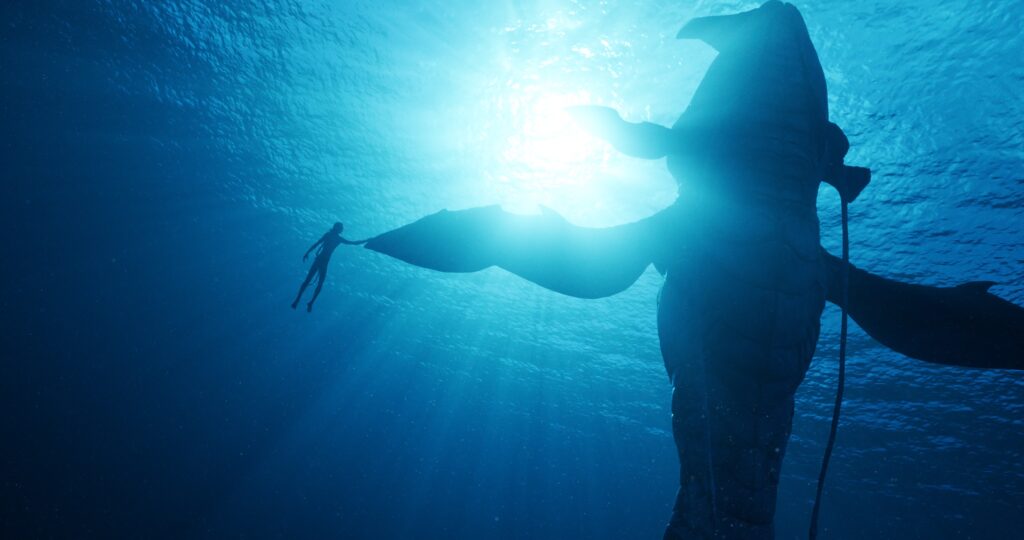
Having seen this, how excited are you to book a return flight to Pandora for parts 3-4 and beyond?
Morgen: I’m suspicious of it/them. I will probably go back for every one of them because no matter what the visuals are consistently beautiful. I remember wanting to watch the first one again and not dreading it in any way. I may not be so psyched to see the second one multiple times, but I have a good feeling that watching it at home (sans IMAX & 3D) will probably change my mind. I’m actually planning to see the plain version with my family when I head home for the holidays so maybe my 2022 final thoughts will revisit this film with more fondness.
Josh: Am I excited for it, per se? Not exactly, but the success of this one means that hype for the next one (which has already been mostly filmed) will be less of a punchline. And even if the plot is light, I will always be up for a ride on Cameron’s space ship. Even though this is a blockbuster of the most cash-consuming order, it’s the rare example that’s not beholden to pre-existing comic book IP, which makes it open to the singular creative vision of a man who loves movies and continues to push the format. For that alone, I’d say he’s earned the credibility to get a return visit whenever he’s ready to roll it out.
Avatar: the Way of Water arrives in theaters on December 16th. See it as big as you can handle.



